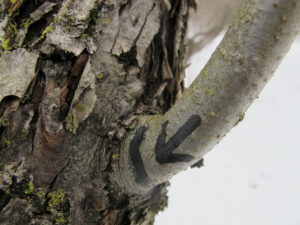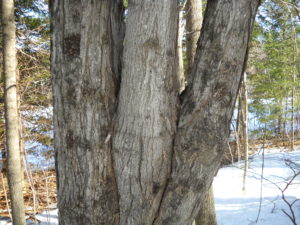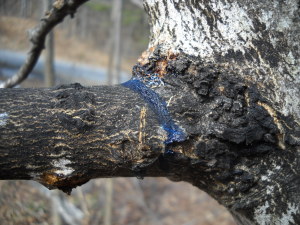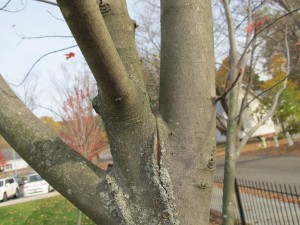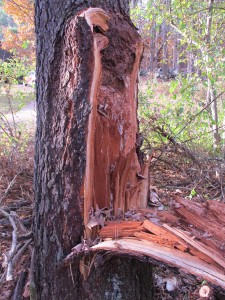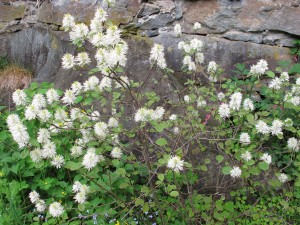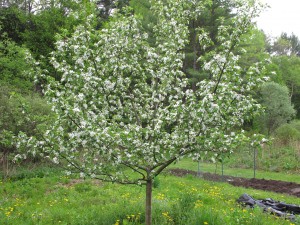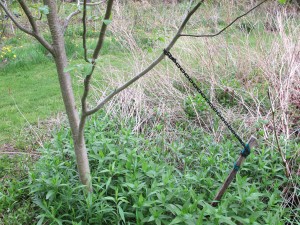8 Steps for Pruning Trees to Perfection
I find it amusing that fruit tree pruning and income tax preparations should take place at about the same time of year, and that many gardeners put off each until the last moment. You might want to start pruning now, instead of trying to do it while adding up your gasoline expenditures and medical expenses.
Below are 8 steps involved in properly pruning a tree. All are designed to create a healthier, more productive tree. By removing clutter you will allow direct sunshine to get to every leaf and wind to circulate, reducing chances of fungal infections. Keep in mind, too, that you can sculpt your tree, too, creating a thing of beauty. For me, that’s an important part of pruning.
- Remove all dead wood. You can tell if a branch is alive, even without leaves, by scratching it with a fingernail. Live twigs will show green when the outer layer of bark is removed. Dead branches will have dry, unhealthy look.
- Remove any diseased or damaged branches. Cracked branches should be removed, though I have had some grow back together by wrapping them tightly for a couple of months.
- If two branches are touching, they will rub and damage bark when the wind blows. Remove one branch.
- Branches should grow outward, away from the center of the tree. Remove any branches that aim back towards the middle of the tree.
- Branches will grow toward the light, and often two will try to fill the same space. If two are growing parallel to each other, remove one of them.
- Many fruit trees grow lots of vertical sprouts each year, each the diameter of a pencil. This is the tree’s way of producing more leaves to feed the roots, but these shoots, known as “water sprouts” will clutter up the tree. Remove most (or all) water sprouts. If you don’t do this every year, the water sprouts will become full-sized branches and your tree will a mess!
- Correct bad crotch angles. Often a branch will grow tight to the main trunk or another branch, creating a tight crotch angle. As the branch gets larger the two will grow together and bark will be swallowed up between them. This is a weak spot, and likely to split if the branches are loaded up with wet snow, or ice. Remove the offending branch – and the sooner the better. Removing a big branch is harder on the tree, and more difficult for you to do.
- Remove low branches that will interfere with mowing. If you have small children you will want them to be able to pick fruit, but you can still create room for the mower and accommodate kids.
Not all trees and shrubs should be pruned now. Spring-blooming shrubs like lilac and forsythia can be pruned, but you will lose blossoms. It’s better to prune after they bloom. Evergreens should be pruned in July after they have produced their new growth. Maples and birch should be done in early summer – right now they will “bleed” sap in large quantities.
How many branches can you take off now? Arborists say that 20% to 25% is fine. More than that, and you will start to starve the roots – leaves provide the food that roots need. That 25% figure is actually of the leaves, not the mass of wood. Dead wood doesn’t count, nor stems that support branches but have no leaves. Taking too many leaves may stimulate the tree to produce large numbers of water sprouts. That said, I once cut a huge lilac to the ground, and it came back nicely. That’s not recommended, however, and it would kill many other tree species.
Lastly, it’s important to know where to make your cuts. Branches generally have a “collar” that is at its attachment point. This collar is wider than the branch, and bark is often wrinkled. You need to cut just beyond the branch collar so that it can heal quickly and avoid infections. If you make a flush cut against the trunk, you open a wider area to diseases and insects, and remove the portion that produces protective compounds to avoid disease.
Pruning should be on your spring calendar just as garden clean-up is on your autumn calendar. But unlike clean-up, pruning get easier with time. A well-pruned tree is better behaved than one that has been ignored for 5 or 10 years. Get some good loppers, by-pass pruners and a pruning saw and get to work! And bring inside a few branches to put in a vase. They may reward you with some nice blossoms long before the outdoor trees do.
Read Henry’s blog posts at https://dailyuv.com/
Pruning Trees and Shrubs
By now you may have your garden put to bed, raked the leaves and planted spring bulbs. I haven’t, but don’t gloat if you have – there is still work to do. This is the time to prune hardwood trees and shrubs (though not evergreens, which should have been pruned back in July). Take a walk around your property and look for scruffy shrubs or trees with deadwood or crossing branches. Trees are healthier and better looking if pruned regularly, meaning at least once a year.
To me, pruning is a joy. I can’t draw a picture, but I can sculpt a tree, making a messy, un-made bed of a tree into something beautiful. If you haven’t dared to prune, give it a try. Even if you make an “oops!” cut, the tree will recover. Start slowly, never taking off more than 25% of the foliage of a tree or shrub in any given year.
Let’s start with how to prune a shrub. Walk around it 3 times, observing its growth. Is it too tall? Too wide? Is the interior of the shrub cluttered with dozens of small branches? Are there dead branches?
It is easiest to prune once the leaves have fallen so one can see the structure of the plant. My late sister, Ruth Anne, loved to start by sitting down or sprawling out underneath a shrub and looking up through it to see where clutter should be removed. Sometimes I do that too, depending on the species.
Begin by removing any dead branches. You can do that any time of the year. If the leaves have dropped and you are not certain if the branch is dead, rub it with your fingernail. If you see green when you scratch the surface, it is alive. Soon you will also notice that the bark on dead branches is a different color, and the bark is often flakey.
Next, look for branches that are rubbing against others, or branches that shoot through the middle of the shrub. Branches should go up or out, not toward the middle. Remove any that do not follow this rule.
It is important to cut branches so that you do not leave any stubs. Cut back a branch to where it originates, either on a bigger branch or to the trunk. Look for the branch “collar”. This is at the point of origin of a branch and is usually swollen and often wrinkled. Leave the branch collar as that is where the tree will heal itself. If you leave a stub past the branch collar, the stub will have to rot off – a long process – before it can heal. That could allow insects or diseases to damage the tree.
Unlike most trees, many shrubs send up multiple stems from the ground. Forsythia, mock orange and many lilacs do this, for example. If you never cut out some stems, the plant will get broader and denser in habit – and lose its graceful appearance. In general, cutting out old stems and encouraging younger growth will invigorate a shrub.
In my opinion, most trees and shrubs look best if their “legs” are exposed. That means the lower part of the stems shouldn’t have side branches and there shouldn’t be uninvited stems to shoot up from the base. Some apple trees are notorious for sending up unwanted shoots from the roots. Cut them off at the ground for a better looking tree.
Speaking of apple trees, most people think they should be pruned in March. In fact, you can prune them now, too. March is a time when farmers and orchardists had time on their hands. But you do no harm by pruning now. Many apples have lots of water sprouts, those pencil-thick stems that shoot straight up. Every year apple tree produce more, and every year I cut them off.
Deer are bad pruners. They go around trees and shrubs nibbling at twigs. Good pruners take larger branches, opening up a tree or shrub to sunlight and better air circulation with a single cut instead of 50 small ones. Taking a big cut is a bit nerve wracking at first, I suppose, but with practice it gets easier. Many trees and shrubs respond to a cut by branching and growing two or more new branches. Make 50 small cuts and you can have 100 new branches. Make a few big cuts and you get just a few new branches.
To prune well and efficiently you need good tools. Don’t go to a big box store and buy the cheapest pruners you can. Go to your garden center and buy a good pair of by-pass pruners. Felco is the most common brand of the good pruners, though I prefer pruner’s made by Bahco. Mine, the PX type, comes in 3 sizes, and left and right handed versions. I got mine from OESCO Inc. (www.oescoinc.com or 800-634-5557) in Conway, MA. I use them daily, and they seem to last forever – with only an occasional sharpening.
You’ll need a saw and some loppers, too. Don’t get a bow saw, get a nice folding saw with a tri-cut blade. And get geared loppers if you can. Fiskars makes nice ones.
So get to work. Most of us have plenty of pruning to do, and a good fall day is the perfect time to do it.
Henry’s website is www.Gardening-Guy.com. He is on vacation this week and not taking questions.
Pruning Maples, Birches and More
Now, as the leaves are disappearing (or accumulating on the lawn, demanding in a whiney voice to be raked up and used for mulch) I am pruning hardwoods like maples, birches and other deciduous trees and shrubs. For me, happiness on a sunny fall day is improving the looks and long-term health of trees by pruning – so I’m out doing some now most nice days.
It’s easier to see the form and structure of trees and shrubs at this time of year because the leaves are mostly gone. I know that some gardeners prefer to prune in the spring – I do fruit trees then – but not all trees can be pruned then. Maples and birches, among others, bleed lots of sap if pruned in March. So I do them now.
Before pruning a young tree, take some time to look at mature trees in your neighborhood. The best ones have open arms: their branches are well spaced and have branches angling off at a 45 degree angle from the trunk. Often these are trees that grow along a fence line or a dirt road so that they had sunshine coming from all sides as they grew.
You may also see some trees that have several fat trunks or stems growing almost parallel, reaching for the sky. These are the trees that split and break off in wind or ice storms. Why? An arborist might use the words “included bark.” This refers to bark that gets engulfed by the growth of 2 trunks that grow too close together. As the trunks grow fatter, bark between them is swallowed up by the two competing trunks, and creates a weak spot that can more easily split.
Recently I saw a large native cherry tree that had split in half. It was, according to my count of the rings, 65-75 years old and it was more than 50 feet tall. Sadly, it had twin trunks and one half split off and fell during a wind storm. I could see that fungus had weakened the wood – the seam between the two trunks was not a tight seal, allowing water and the fungus to enter. And now the remaining trunk is open to the elements and will not survive as long as it might otherwise.
If you have a young tree that has branches or trunks that are growing together and have a tight angle between them, you should act. You will need to remove one of the competing stems. This may seem drastic, and is best done before the stems are more than 2 or 3 inches in diameter. I removed a few recently while working at the Kilton Library in West Lebanon, NH.
Of course, removing a 2-inch stem also means you will lose all the side branches that are growing on it, too. Before unsheathing my big pruning saw I walked around each tree for several minutes. I looked at the two competing stems and tried to mentally erase one from the picture I was looking at. Would there be a big gap in the canopy? Would there be small branches that could fill in after surgery? Yes, there are always small branches that will fill in.
There are also “dormant buds” on trees that can produce branches if the tree “senses” a gap in the canopy. Trees, obviously, don’t have brains that tell them when to send out new branches. But there are stimuli such as sunshine coming through an empty spot in the canopy that will “tell” the tree to set out new growth.
At Kilton Library (where all the trees were planted in 2010) I studied the trees that I had pruned last year. I had removed some two-inch diameter stems that were growing together too tightly. I was pleased to see that the trees looked full. No big gaps. In general, removing a big stems or branch does not seem so drastic after it’s gone – even though it seems scary when it’s time to cut. And removing a big branch helps the tree to be more open, thus allowing every leaf to get some direct sunshine, which is good.
At the back of the property there is a maple that “wanted” to send branches over the fence and reach out for sunshine on the neighbor’s property. I noticed that one branch I had removed last year – only an inch in diameter or so – had sent a new branch back over the fence. Amazingly, it had grown 5 feet in one year! Interestingly, the leaves on it were nearly twice the size of the leaves on the rest of the tree. So trees will keep on producing branches to take advantage of sunshine, no matter what we do.
So if you haven’t taken a good look at the arrangement of trunks and larger branches on your trees, this is a good time to do so. You might be able to prune them yourself, but you might have to call an arborist who can take out a large branch or trunk if need be. It would be money well spent – 50 years from now you just might lose a tree, or half a tree, if you don’t do so.
Henry Homeyer is the author of 4 gardening book, and a children’s chapter book, a fantasy-adventure about a boy and a cougar. His web sites are www.gardening-guy.com and www.henryhomeyer.com.
Selecting and Training Flowering Trees
This has been a great year for flowering trees and shrubs. My Merrill magnolia had many hundreds of white blossoms in late April.
The crabapples everywhere put on a spectacular display this year. My fothergilla (a shrub with great fall leaf color) is in bloom now with its tidy white bottle-brush flowers. My ‘Olga Mezitt’ rhododendron (one of the parents of the popular PJM rhodie) is looking great and my wild azaleas are getting ready to bloom. And now the lilacs are blooming for me and I am overwhelmed with the large purple, blue, white and pink panicles (clusters of flowers). Spring has definitely sprung.
All these blooms this year will certainly encourage many gardeners to buy trees and shrubs and plant them. That’s a fine idea, but if you plant now, please remember that you must keep watering them all summer if we don’t get an inch or more of rain per week. When August comes around it will be easy to have your new tree dehydrate if you get lazy or forgetful.
New trees and shrubs need a year or more to grow roots sufficient for their needs if we get hot, dry weather. So if you are forgetful or will be doing lots of traveling, you might want to hold off on planting a new tree until fall, which is also a good time for planting. Fall is cooler and more likely to be rainy.
I like to buy flowering trees and shrubs when they’re in bloom. That allows me to see the color and check out the fragrance. But there is more than just the flowers to consider when selecting a good crabapple or magnolia. Let’s start with size and price. Bigger
is not necessarily better. If you are on life support and don’t expect to be around in 5 years, sure, buy the biggest tree you can afford. But be aware that a bigger tree is not only more expensive – it is also harder to plant and takes more water and care. A bigger tree may have a smaller proportion of its root system intact after being dug up and put in a pot than a small tree. I like to buy smaller specimens and then train them to be a nice shape. That’s harder to do on a larger tree.
I recently visited a nice new nursery run by Henderson’s Tree Service on Rte 14 in Hartford, Vermont. There I chatted with my friend Sylvia Provost who is co-owner of the business. I asked Sylvia what she would look for if purchasing a crabapple for herself. Without a moment’s hesitation she responded. “Structure,” she said.
What Sylvia was talking about is the shape of the tree and the placement of the branches. Fruit trees produce best on branches that leave the trunk at a right angle or are aiming just slightly upward. Branches that shoot straight up are not usually good fruit and blossom producers.
And although Sylvia noted that you can train a tree to be the shape you want, it is easier to start with something that is closer to your ideal before you start training. So, for example, Sylvia said that if you have a swimming pool some distance from your patio, you should choose a tree that has an open format, one that you can see through – and see what is happening at the pool. Conversely, if you have nosy neighbors and want to screen their view of your patio, you might select a tree that has a full, dense arrangement of branches.
Generally, pruning a tree should begin in the second year of its life at your home. I often see apple and crabapple trees that have very low branches. I like to prune off those low branches to make it easy to mow around, and to have a nicer look. And if two branches are both striving to be the “leader” or the dominant, tallest stem, I remove one. And although most books say you should prune fruit trees in March or April, you can safely make a few judicious cuts now to train your tree.
You may train branches to grow at different angles by weighing them down – if you do so soon. This is an activity for spring, starting before the new layer of cambium growth has occurred. You can drive a stake into the ground and tie a branch to it for the next 2 months. A branch the diameter of a finger can weighed down by hanging a plastic pop bottle on it, then filling it with water until it bends to the correct angle.
Chris Wilson of the EC Brown Nursery in Thetford, Vermont suggested that when buying a tree, look at leaf color – leaves should be green, not tinged with yellow. He also suggested making sure the tree has branches on all sides, and that the bark has not been damaged.
So if you’ve delighted in the flowers on trees in your neighborhood this year, go get one or more. Study several specimens to find the best one. And just remember to water all summer long!
Henry Homeyer is a gardener and garden designer living in Cornish flat, NH. His Web site is www.Gardening-Guy.com.



